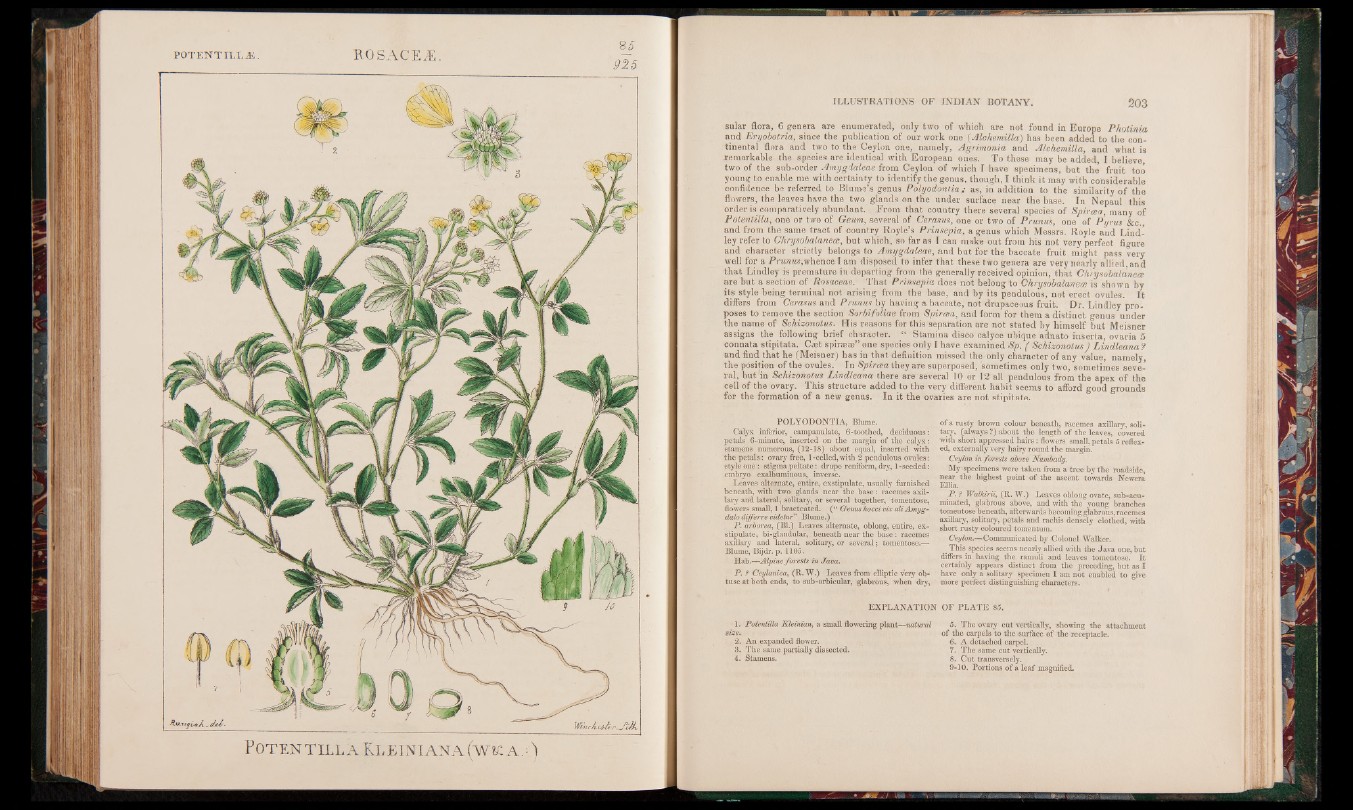
POTENTILLÆ. ROSACEÆ. 8 /
9 2 5
POTENTILLA IvL EINIANA (WK A.=')
sular flora, 6 genera are enumerated, only two of which are not found in Europe P h o tin ia
and Eryobotria, since the publication of our work one (M ch em illa ) has been added to the continental
flora and two to the Ceylon one, namely, A g r im a n ia and M ch em illa , and what is
remarkable the species are identical with European ones. To these may be added I believe
two of the sub-order Amygdaleae from Ceylon of which I have specimens, but the fruit too
young to enable me with certainty to identify the genus, though, I think it may with considerable
confidence be referred to Blume’s genus P o lyo d o n tia ; as, in addition to the similarity of the
flowers, the leaves have the two glands on the under surface near the base. In Nepaul this
order is_ comparatively abundant. From that country there several species of Spircea, many of
P o ten tilla , one or two of Geum, several of Cerasus, one or two of P ru n u }, one of p 'y ru s &c.,
and from the same tract of country Royle’s P rin sep ia , a genus which Messrs. Royle and Lind-
ley refer to Chrysobalanece, but which, so far as I can make out from his not very perfect figure
and character strictly belongs to Am yg d a lea e, and but for the baccate fruit might pass very
well for a P r im u s ,whence I am disposed to infer that these two genera are very nearly allied, and
that Lindley is premature in departing from the generally received opinion, that Chrysobalanece
are bat a section of Rosaceae. That Prinsepia does not belong to Chrysobalanece is shown by
its style being terminal not arising from the base, and by its pendulous, not erect ovules. It
differs from Cerasus and P r im u s byhaving a baceate, not drupaceous fruit. Dr. Lindley proposes
to remove the section Sorbifoliae from Spircea, and form for them a distinct genus under
the name of Schizonotus. His reasons for this separation are not stated by himself but Meisner
assigns the following brief character. “ Stamina disco calyce ubique adnato inscrta, ovaria 5
connata stipitata. Cast spiraeae” one species only I have examined Sp. ( S ch izo n o tu sJ L in d le a n a ?
and find that he (Meisner) has in that definition missed the Only character of any value, namely,
the position of the ovules. In Spircea they are superposed, sometimes only two, sometimes several,
but in Schizonotus L in d le a n aThere are several 10 or 12 all pendulous from the apex of the
cell of the ovary. This structure added to the very different habit seems to afford good grounds
for the formation of a new genus. In it the ovaries are not stipitate.
POLYODONTIA, Blume.
Calyx inferior, campanulate, 6-toothecL, deciduous:
petals 6-minute, inserted on the margin of the calyx:
stamens numerous, (12-18) about equal, inserted with
the petals: ovary free, 1-celled,with 2 pendulous ovules:
style one : stigma peltate: drupe reniform, dry, 1-seeded:
embryo exalhuminous, inverse.
Leaves alternate, entire, exstipulate, usually furnished
beneath, with two glands near the base: racemes axillary
and lateral, solitary, or several together, tomentose,
flowers small, 1 bracteated. ( “ Genas hocci vix ali Amygdala
differre videtur" Blume.)
P. arborea, (Bl.) Leaves alternate, oblong, entire, exstipulate,
bi-glandular, beneath near the base: racemes
axillary and lateral, solitary, or several; tomentose.—
Blume, Bijdr. p. 1105.
Hab.—Alpine forests in Java.
P. f Ceylanica, (R. W.) Leaves from elliptic very obtuse
at both ends, to sub-orbicular, glabrous, when dry,
EXPLANATION
1. Potentilla Kleinian, a small flowering plant—natural
size.
2. An expanded flower.
3. The same partially dissected.
4. Stamens.
o f a rusty brown colour beneath, racemes axillary, solitary,
(always ?) about the length of the leaves, covered
with short appressed hairs: flowers small, petals 5 reflexed,
externally very hairy round the margin.
Ceylon in forests above Numbady.
My specimens were taken from a tree by the roadside,
near the highest point of the ascent towards Newera
Ellia.
P. ? Walkirii, (R. W.) Leaves oblong ovate, sub-acuminated,
glabrous above, and with the young branches
tomentose beneath, afterwards becoming glabrous, racemes
axillary, solitary, petals and rachis densely clothed, with
short rusty coloured tomentum.
Ceylon.—Communicated by Colonel Walker.
This species seems nearly allied with the Java one, but
differs in having the ramuli and leaves tomentose. It
certainly appears distinct from the preceding, but as I
have only a solitary specimen I am not enabled to give
more perfect distinguishing characters.
OF PLATE 85.
5. The ovary cut vertically, showing the attachment
of the carpels to the surface of the receptacle.
6. A detached carpel.
7. The same cut vertically.
8. Cut transversely.
9-10. Portions of a leaf magnified.